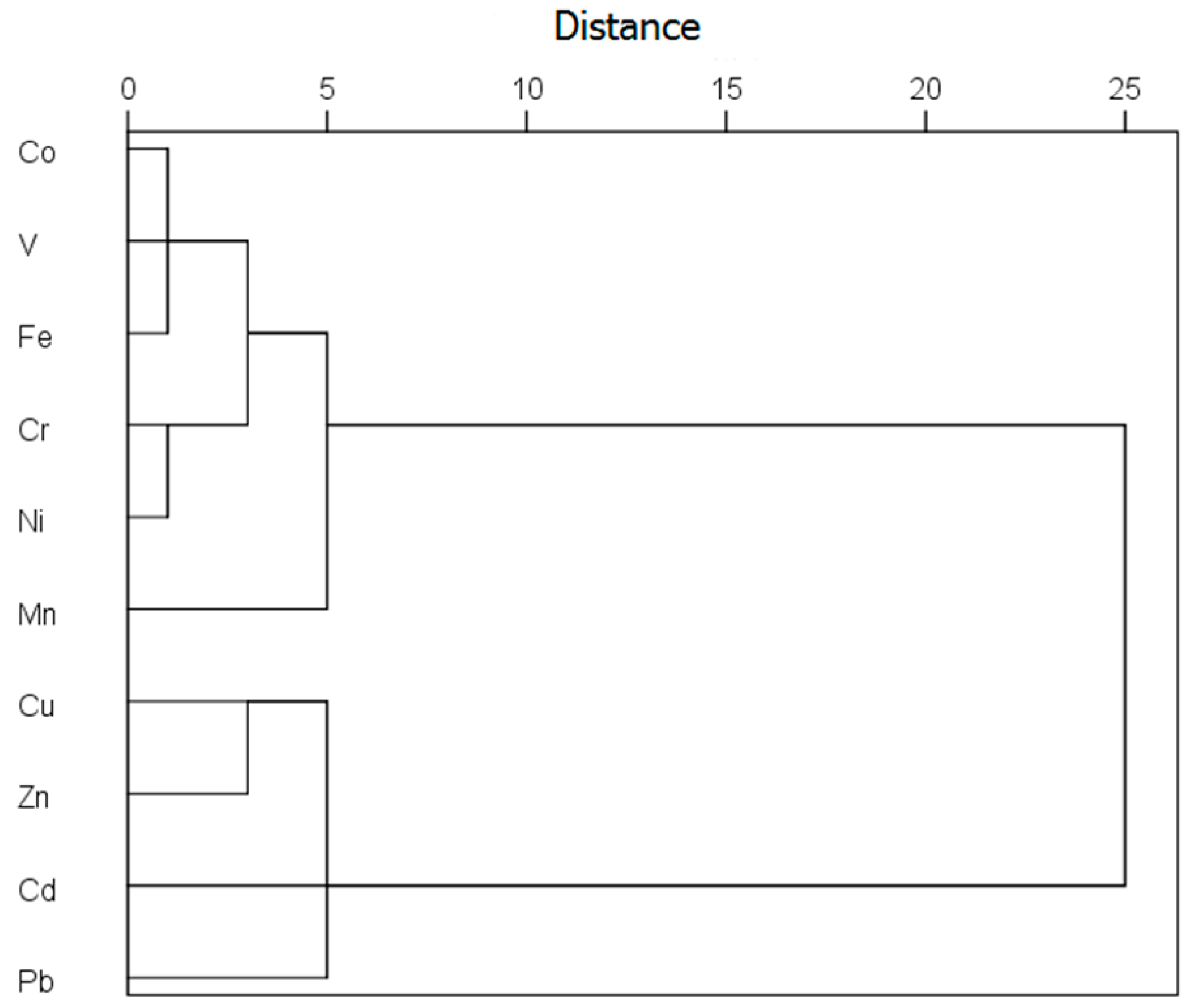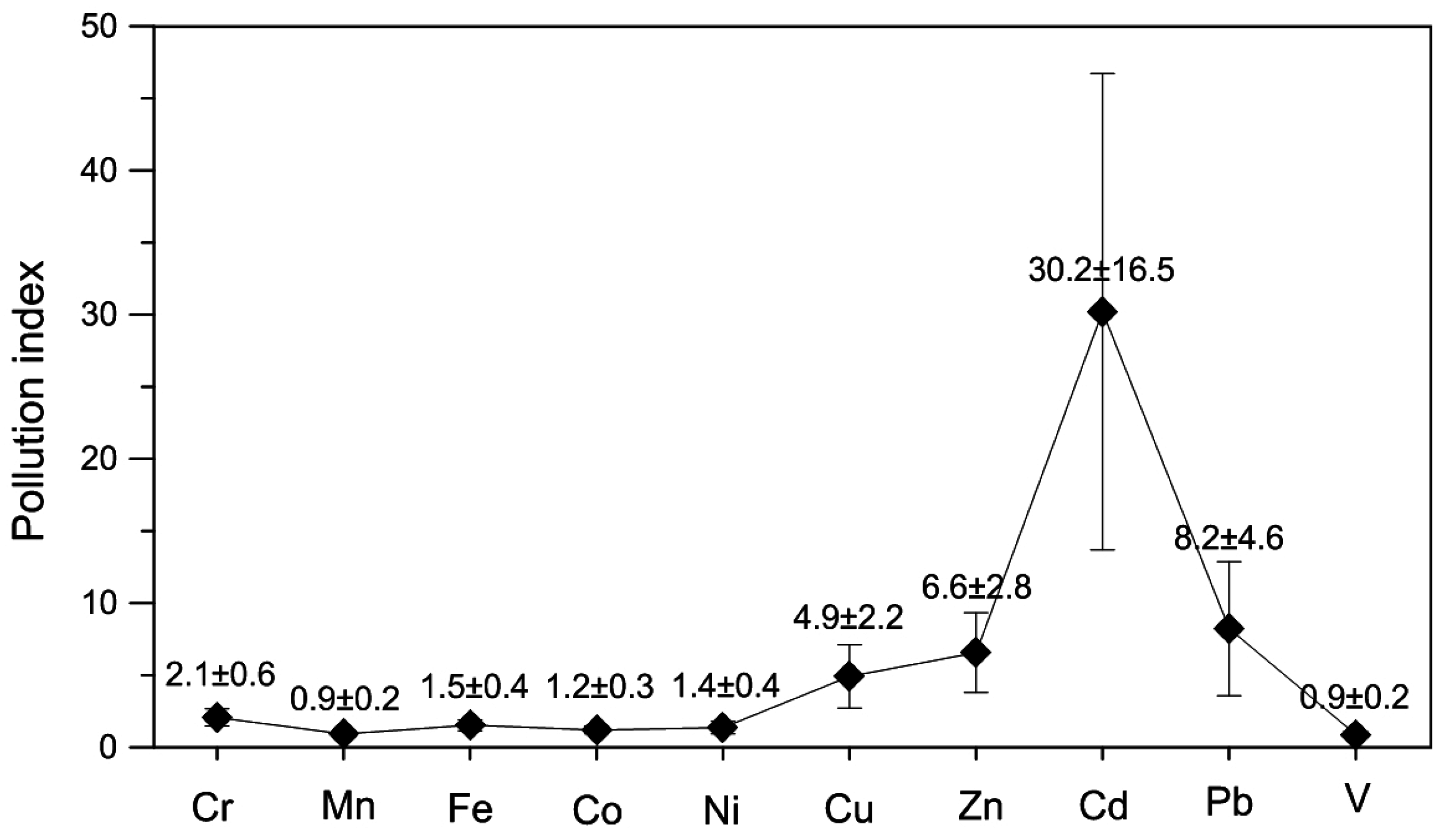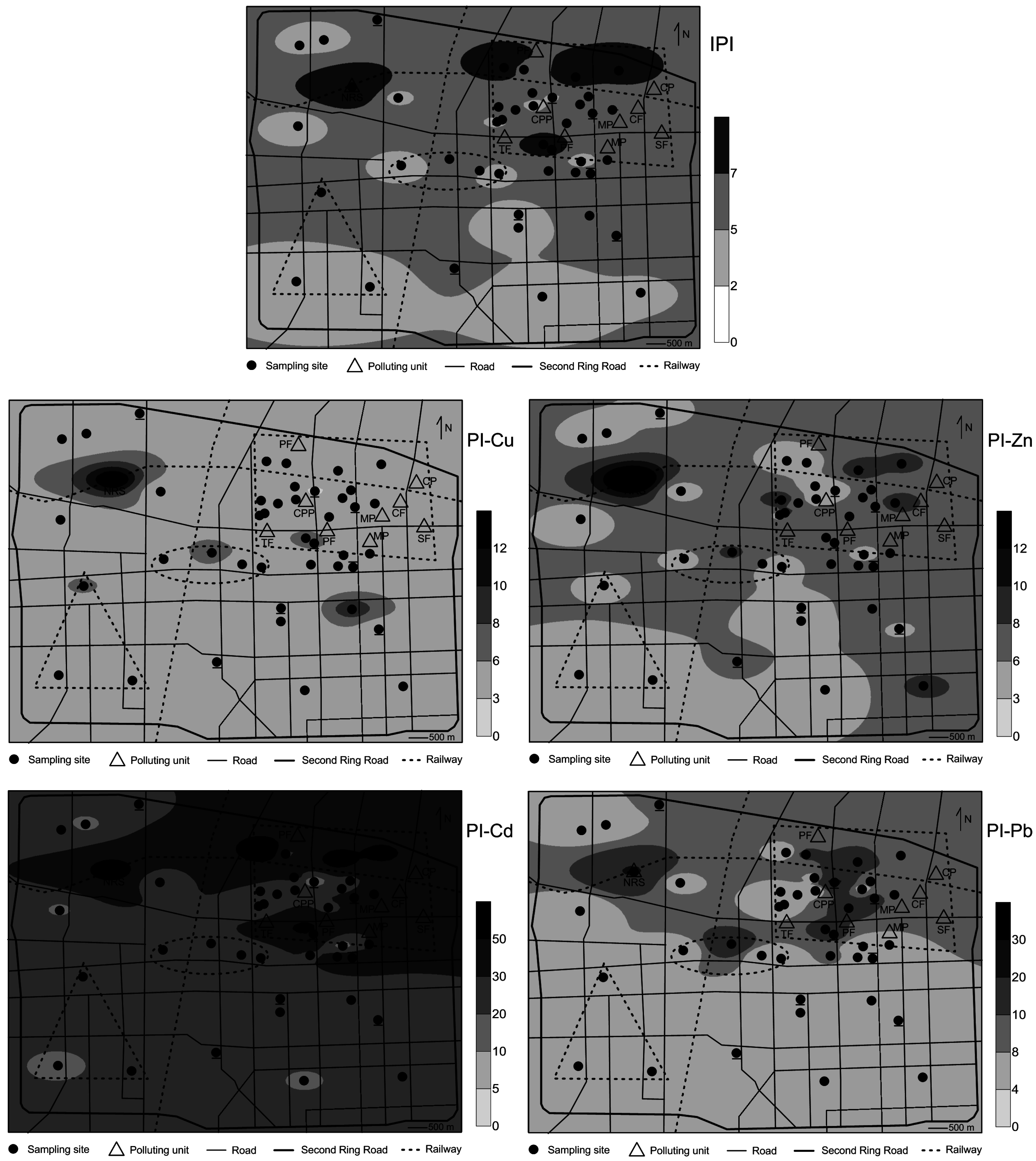Heavy Metal Pollution in Settled Dust Associated with Different Urban Functional Areas in a Heavily Air-Polluted City in North China
Abstract
:1. Introduction
2. Materials and Methods
2.1. Study Area
2.2. Sampling and Analysis
2.3. Enrichment Factor (EF)
2.4. Integrated Pollution Index
3. Results and Discussion
3.1. Heavy Metal Concentrations in the Settled Dust
3.2. Enrichment Factors of Heavy Metals
3.3. Spatial Distribution and Sources of Heavy Metals in Dust from Different Functional Areas
4. Conclusions
Acknowledgments
Author Contributions
Conflicts of Interest
Abbreviations
| UCC | Upper Continental Crust |
| EF | Enrichment factor |
| IPI | Integrated pollution index |
| PI | Pollution index |
References
- Järup, L. Hazards of heavy metal contamination. Br. Med. Bull. 2003, 68, 167–182. [Google Scholar] [CrossRef] [PubMed]
- Tchounwou, P.B.; Yedjou, C.G.; Patlolla, A.K.; Sutton, D.J. Heavy metal toxicity and the environment. In Molecular, Clinical and Environmental Toxicology; Springer: Basel, Switzerland, 2012; pp. 133–164. [Google Scholar]
- Duan, J.; Tan, J. Atmospheric heavy metals and arsenic in China: Situation, sources and control policies. Atmos. Environ. 2013, 74, 93–101. [Google Scholar] [CrossRef]
- He, B.; Yun, Z.J.; Shi, J.B.; Jiang, G. Research progress of heavy metal pollution in China: Sources, analytical methods, status, and toxicity. Chin. Sci. Bull. 2013, 58, 134–140. [Google Scholar] [CrossRef]
- Li, X.Y. Levels and spatial distribution of heavy metals in urban dust in China. Chin. J. Geochem. 2015, 34, 498–506. [Google Scholar] [CrossRef]
- Wang, J.; Hu, Z.; Chen, Y.; Chen, Z.; Xu, S. Contamination characteristics and possible sources of PM10 and PM2.5 in different functional areas of Shanghai, China. Atmos. Environ. 2013, 68, 221–229. [Google Scholar] [CrossRef]
- Zhao, P.S.; Dong, F.; He, D.; Zhao, X.J.; Zhang, X.L.; Zhang, W.Z.; Yao, Q.; Liu, H.Y. Characteristics of concentrations and chemical compositions for PM2.5 in the region of Beijing, Tianjin, and Hebei, China. Atmos. Chem. Phys. 2013, 13, 4631–4644. [Google Scholar] [CrossRef]
- Pan, Y.; Tian, S.; Li, X.; Sun, Y.; Li, Y.; Wentworth, G.R.; Wang, Y. Trace elements in particulate matter from metropolitan regions of Northern China: Sources, concentrations and size distributions. Sci. Total Environ. 2015, 537, 9–22. [Google Scholar] [CrossRef] [PubMed]
- Wang, L.; Wei, Z.; Wei, W.; Fu, J.S.; Meng, C.; Ma, S. Source apportionment of PM2.5 in top polluted cities in Hebei, China using the CMAQ model. Atmos. Environ. 2015, 122, 723–736. [Google Scholar] [CrossRef]
- Zhang, L.; Jin, X.; Johnson, A.C.; Giesy, J.P. Hazard posed by metals and As in PM2.5 in air of five megacities in the Beijing-Tianjin-Hebei region of China during APEC. Environ. Sci. Pollut. Res. 2016, 23, 1–10. [Google Scholar] [CrossRef] [PubMed]
- Sun, Y.; Zhou, Q.; Xie, X.; Liu, R. Spatial, sources and risk assessment of heavy metal contamination of urban soils in typical regions of Shenyang, China. J. Hazard. Mater. 2010, 174, 455–462. [Google Scholar] [CrossRef] [PubMed]
- Bi, X.; Li, Z.; Sun, G.; Liu, J.; Han, Z. In vitro bioaccessibility of lead in surface dust and implications for human exposure: A comparative study between industrial area and urban district. J. Hazard. Mater. 2015, 297, 191–197. [Google Scholar] [CrossRef] [PubMed]
- Wei, X.; Gao, B.; Wang, P.; Zhou, H.; Lu, J. Pollution characteristics and health risk assessment of heavy metals in street dusts from different functional areas in Beijing, China. Ecotoxicol. Environ. Saf. 2015, 112, 186–192. [Google Scholar] [CrossRef] [PubMed]
- Trujillo-González, J.M.; Torres-Mora, M.A.; Keesstra, S.; Brevik, E.C.; Jiménez-Ballesta, R. Heavy metal accumulation related to population density in road dust samples taken from urban sites under different land uses. Sci. Total Environ. 2016, 553, 636–642. [Google Scholar] [CrossRef] [PubMed]
- Wan, D.; Zhan, C.; Yang, G.; Liu, X.; Yang, J. Preliminary Assessment of Health Risks of Potentially Toxic Elements in Settled Dust over Beijing Urban Area. Int. J. Environ. Res. Public Health 2016, 13, 491. [Google Scholar] [CrossRef] [PubMed]
- Report on the Environment State in China in 2013. Available online: http://jcs.mep.gov.cn/hjzl/zkgb/2013zkgb/201406/t20140605_276521.shtml (accessed on 5 September 2016). (In Chinese)
- Report on the Environment State in China in 2014. Available online: http://jcs.mep.gov.cn/hjzl/zkgb/2014zkgb/201506/t20150608_303142.htm (accessed on 5 September 2016). (In Chinese)
- Han, Y.M.; Du, P.X.; Cao, J.J.; Posmentier, E.S. Multivariate analysis of heavy metal contamination in urban dusts of Xi’an, Central China. Sci. Total Environ. 2006, 355, 176–186. [Google Scholar]
- Zheng, N.; Liu, J.; Wang, Q.; Liang, Z. Health risk assessment of heavy metal exposure to street dust in the zinc smelting district, Northeast of China. Sci. Total Environ. 2010, 408, 726–733. [Google Scholar] [CrossRef] [PubMed]
- Kong, S.F.; Lu, B.; Bai, Z.P.; Zhao, X.Y.; Chen, L.; Han, B.; Li, Z.Y.; Ji, Y.Q.; Xu, Y.H.; Liu, Y.; et al. Potential threat of heavy metals in re-suspended dusts on building surfaces in oilfield city. Atmos. Environ. 2011, 45, 4192–4204. [Google Scholar] [CrossRef]
- Lu, X.W.; Zhang, X.L.; Li, L.Y.; Chen, H. Assessment of metals pollution and health risk in dust from nursery schools in Xi’an, China. Environ. Res. 2014, 128, 27–34. [Google Scholar] [CrossRef] [PubMed]
- Wan, D.; Han, Z.; Liu, D.; Yang, J. Spatial distribution and pollution levels of heavy metals in house dust from an industrial area in Xi’an, Central China. Fresenius Environ. Bull. 2016, 25, 839–851. [Google Scholar]
- CNEMC (China National Environmental Monitoring Center). The Background Values of Elements in Chinese Soils; Environmental Science Press China: Beijing, China, 1990; pp. 330–496. (In Chinese) [Google Scholar]
- Wei, B.; Yang, L. A review of heavy metal contaminations in urban soils, urban road dusts and agricultural soils from China. Microchem. J. 2010, 94, 99–107. [Google Scholar] [CrossRef]
- Yaylalı-Abanuz, G. Heavy metal contamination of surface soil around Gebze industrial area, Turkey. Microchem. J. 2011, 99, 82–92. [Google Scholar] [CrossRef]
- Taghipour, H.; Mosaferi, M.; Armanfar, F.; Gaemmagami, S.J. Heavy metals pollution in the soils of suburban areas in big cities: A case study. Int. J. Environ. Sci. Technol. 2013, 10, 243–250. [Google Scholar] [CrossRef]
- Taylor, S.R.; McLennan, S.M. The geochemical evolution of the continental crust. Rev. Geophys. 1995, 33, 241–265. [Google Scholar] [CrossRef]
- Yang, Z.; Ge, H.; Lu, W.; Long, Y. Assessment of heavy metals contamination in near-surface dust. Pol. J. Environ. Stud. 2015, 24, 1817–1829. [Google Scholar] [CrossRef]
- Chen, H.; Lu, X.W.; Li, L.Y. Spatial distribution and risk assessment of metals in dust based on samples from nursery and primary schools of Xi’an, China. Atmos. Environ. 2014, 88, 172–182. [Google Scholar] [CrossRef]
- Chen, M.; Pi, L.; Luo, Y.; Geng, M.; Hu, W.; Li, Z.; Su, S.; Can, Z.; Ding, S. Grain Size Distribution and Health Risk Assessment of Metals in Outdoor Dust in Chengdu, Southwestern China. Arch. Environ. Contam. Toxicol. 2016, 70, 534–543. [Google Scholar] [CrossRef] [PubMed]
- Mbengue, S.; Alleman, L.Y.; Flament, P. Metal-bearing fine particle sources in a coastal industrialized environment. Atmos. Res. 2017, 183, 202–211. [Google Scholar] [CrossRef]
- Weckwerth, G. Verification of traffic emitted aerosol components in the ambient air of Cologne (Germany). Atmos. Environ. 2001, 35, 5525–5536. [Google Scholar] [CrossRef]
- Liu, H.; Chen, L.-P.; Ai, Y.-W.; Yang, X.; Yu, Y.-H.; Zuo, Y.-B.; Fu, G.-Y. Heavy metal contamination in soil alongside mountain railway in Sichuan, China. Environ. Monit. Assess. 2009, 152, 25–33. [Google Scholar] [CrossRef] [PubMed]
- Thorpe, A.; Harrison, R.M. Sources and properties of non-exhaust particulate matter from road traffic: A review. Sci. Total Environ. 2008, 400, 270–282. [Google Scholar] [CrossRef] [PubMed]
- Wan, D.; Song, L.; Yang, J.; Jin, Z.; Zhan, C.; Mao, X.; Liu, D.; Shao, Y. Increasing heavy metals in the background atmosphere of central North China since the 1980s: Evidence from a 200-year lake sediment record. Atmos. Environ. 2016, 138, 183–190. [Google Scholar] [CrossRef]
- Pye, K. Aeolian Dust and Dust Deposits; Academic Press: London, UK, 1987. [Google Scholar]
- Report of PM2.5 Sources in Shijiazhuang City. Available online: http://www.he.xinhuanet.com/news/2014-08/29/c_1112288346.htm (accessed on 6 September 2016). (In Chinese)
- Qiao, Q.; Huang, B.; Zhang, C.; Piper, J.D.; Pan, Y.; Sun, Y. Assessment of heavy metal contamination of dustfall in northern China from integrated chemical and magnetic investigation. Atmos. Environ. 2013, 74, 182–193. [Google Scholar] [CrossRef]





| Location | Type | Item | Cr | Mn | Fe | Co | Ni | Cu | Zn | Cd | Pb | V | Data Source |
|---|---|---|---|---|---|---|---|---|---|---|---|---|---|
| mg·kg−1 | |||||||||||||
| Shijiazhuang | Settled dust (<63 μm) | Min | 79.7 | 370.9 | 25,983 | 8.1 | 22.2 | 48.5 | 267.2 | 0.86 | 71.2 | 33.9 | This study |
| Max | 279.6 | 852.1 | 78,899 | 26.2 | 82.9 | 330.1 | 1485.8 | 8.28 | 571.3 | 114.9 | |||
| Median | 137.9 | 556.0 | 42,715 | 14.1 | 39.2 | 99.6 | 466.9 | 2.40 | 146.9 | 63.7 | |||
| Average | 141.4 | 562.3 | 43,348 | 14.9 | 42.1 | 107.3 | 514.5 | 2.84 | 177.0 | 65.9 | |||
| Stdev | 41.2 | 102.2 | 10,692 | 3.3 | 13.7 | 47.9 | 216.6 | 1.55 | 99.9 | 14.9 | |||
| EF | 2.4 ± 0.4 | 1.1 ± 0.1 | 1.8 ± 0.2 | 1.4 ± 0.1 | 1.6 ± 0.2 | 5.7 ± 1.7 | 7.6 ± 2.7 | 38.7 ± 19.7 | 9.5 ± 5.7 | 1.0 ± 0.1 | |||
| Hebei | Natural soil | Average | 68.3 | 608 | 28,200 | 12.4 | 30.8 | 21.8 | 78.4 | 0.09 | 21.5 | 73.2 | [23] |
| UCC | - | Average | 35 | 600 | 35,000 | 10 | 20 | 25 | 71 | 0.098 | 20 | 60 | [27] |
| Beijing | Settled dust (<63 μm) | Average | 86.0 | 607.1 | - | 10.6 | 45.2 | 138.4 | 722.7 | 2.29 | 167.9 | 57.9 | [15] |
| Changchun | Surface dust (<0.8 mm) | Average | 96.0 | 692.0 | - | - | - | 68.4 | 465.4 | - | 93.6 | - | [28] |
| Xi’an | School dust (<75 μm) | Average | 149.2 | 558.3 | - | 43.4 | 34.6 | 70.8 | 461.5 | - | 180.9 | 67.6 | [29] |
| Wuhan | Surface dust (<250 μm) | Average | 130 | - | - | 14 | 33 | 138 | 835 | - | 281 | - | [12] |
| Chengdu | Outdoor Dust (<63 μm) | Average | 143 | 817 | - | 14.3 | 48.0 | 139 | 1150 | 2.12 | 114 | - | [30] |
| Functional Area | No. | Cr | Mn | Fe | Co | Ni | Cu | Zn | Cd | Pb | V |
|---|---|---|---|---|---|---|---|---|---|---|---|
| mg·kg−1 | |||||||||||
| North Railway Station | 1 | 279.6 | 810.6 | 78,899 | 26.2 | 82.9 | 330.1 | 1485.8 | 6.12 | 470.0 | 114.9 |
| Industrial area | 16 | 143.2 | 555.2 | 41,630 | 14.7 | 43.0 | 101.2 | 560.0 | 3.58 | 173.2 | 63.2 |
| Heavily trafficked area | 8 | 142.8 | 571.1 | 44,948 | 15.1 | 40.5 | 103.9 | 471.2 | 2.70 | 228.6 | 67.0 |
| Commercial area | 4 | 126.8 | 539.4 | 43,548 | 14.5 | 43.3 | 112.2 | 476.4 | 2.13 | 180.0 | 66.7 |
| Administration-education area | 3 | 160.3 | 579.7 | 43,894 | 16.0 | 42.2 | 102.2 | 395.6 | 1.90 | 136.4 | 72.1 |
| Other unclassified sites | 11 | 125.2 | 547.1 | 41,228 | 13.9 | 37.8 | 97.9 | 442.1 | 2.02 | 128.2 | 62.7 |
© 2016 by the authors; licensee MDPI, Basel, Switzerland. This article is an open access article distributed under the terms and conditions of the Creative Commons Attribution (CC-BY) license (http://creativecommons.org/licenses/by/4.0/).
Share and Cite
Wan, D.; Han, Z.; Yang, J.; Yang, G.; Liu, X. Heavy Metal Pollution in Settled Dust Associated with Different Urban Functional Areas in a Heavily Air-Polluted City in North China. Int. J. Environ. Res. Public Health 2016, 13, 1119. https://doi.org/10.3390/ijerph13111119
Wan D, Han Z, Yang J, Yang G, Liu X. Heavy Metal Pollution in Settled Dust Associated with Different Urban Functional Areas in a Heavily Air-Polluted City in North China. International Journal of Environmental Research and Public Health. 2016; 13(11):1119. https://doi.org/10.3390/ijerph13111119
Chicago/Turabian StyleWan, Dejun, Zhangxiong Han, Jinsong Yang, Guanglin Yang, and Xingqi Liu. 2016. "Heavy Metal Pollution in Settled Dust Associated with Different Urban Functional Areas in a Heavily Air-Polluted City in North China" International Journal of Environmental Research and Public Health 13, no. 11: 1119. https://doi.org/10.3390/ijerph13111119






